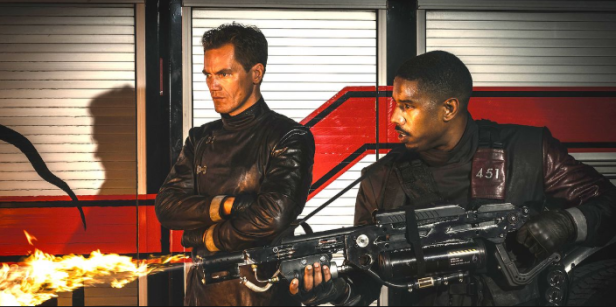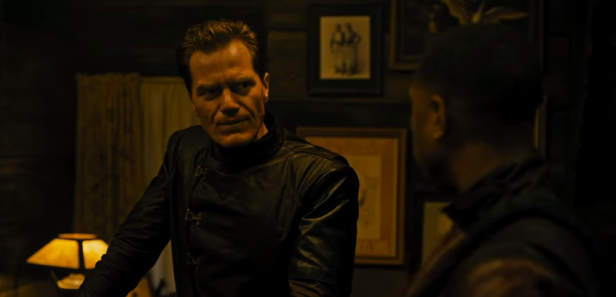Adapting stories from classic literature is a tricky business; It doesn’t always garner a positive result and typically leans more toward a derivative nature. When stories become outdated based on modern day standards, it could either be a daunting task or maybe even a fruitful opportunity. For Ray Bradbury’s most famous written work Fahrenheit 451, it is a story (a short one in fact, with only 165 pages minus the afterword) that has been unadulterated in literary form since its publishing year of 1953. While it has been adapted into a vast array of other mediums throughout the better part of a century (including the 1966 film directed by the great French New Wave auteur François Truffaut) the novel is still intact with its original words and ideas, untouched by Bradbury throughout the decades. It’s most recent iteration – the 2018 film written and directed by Ramin Bahrani (that was produced and delivered to the small screen by HBO), takes its own creative liberties that some might argue was necessary for a much-needed update.
TABLE SETTING/FIRST-ACT
Fahrenheit 451 (2018) is set in a sprawling urban center in what is the distant future, but I would be willing to express that this it could be considered as “not so” distant (particularly based off today’s standards). In contrast to 2018, Fahrenheit 451 is still a futuristic setting and very much a dystopian society. Cloaked in a fascist social order where all media is controlled, restricted, and vastly outlawed, this world is separated by the oppressed, unconscious, and consumer-obsessed citizens from its knowledge-hungry, book-reading rebel counterparts (known as “Eels”). There is a third power at work here: the firemen who are otherwise known as the “salamanders.” These fire burners are tasked with ridding the world of outlawed and unsanctioned content by means of fire at all cost. In a dystopian world that teaches that the first firemen did not put fires out but started them, a firefighter known as Guy Montag (played by Michael B. Jordan) has quickly moved through the ranks under close, father-like mentorship to his Fire Captain, Beatty (played by Michael Shannon). Montag, in his gung-ho, jingoistic hoopla, helps to usher his fellow ceremonious and cult-like salamanders into the fire without much thought or care for the societal consequences – a result to the long-molded teachings by the hardened superior Beatty through his pseudo-fatherly guidance.

- “Knowledge is a dangerous thing.”
Much like Bradbury’s iteration, Fahrenheit 451 (2018) doesn’t take too much time for Montag to begin to awaken to his societally-restricted reality. He soon begins to question his world, the consequences of his actions, and to find a more righteous path to understanding and purpose. Once he encounters a young woman named Clarisse McClellan (played by Sofia Boutella), Montag begins to understand there is something truly sinister in his former life-long desire to “burn” as a fireman. Clarisse is discovered to be an eel, involved in a rebellious organization with mysterious intentions. Montag is pushed into a state of curious and chaotic confusion when he encounters another eel willing to sacrifice herself for the rebellious cause – seamlessly exclaiming the word “OMNIS” before bursting into flames all while surrounded by her vast (and illegal) collection of books. The mystery of OMNIS becomes an object of calamity for the salamanders and their fascist society, and responsibility falls on Captain Beatty to uproot this OMNIS and its purpose at all cost.
DIRECTION, DISSECTION & VERDICT
While Beatty insists upon his firemen to do their sworn duty, Montag begins to deviate from his father-figure’s wishes and the Salamander cause. Through a not-so-surprising turn of events, Montag swears to the Eels to help bring the OMNIS into being (which is a narrative concept I must admit doesn’t translate well during Fahrenheit’s already limited, 101-minute runtime). Captain Beatty becomes more suspecting to Montag’s fading devotion as time goes on, and their two dynamic ideologies collide head-first later in the film that results in a dramatic falling out and a war on two fronts.

- “I got things inside my head that don’t make sense…”
To my surprise, two major characters from Bradbury’s novel were removed from Ramin Bahrani’s Fahrenheit 451. First is Mildred: the ignorant wife of Guy Montag and the physical representation and product of her environment. Mildred is a blissful individual fully obsessed with impracticality and someone truly checked out of reality – lacking consciousness, empathy, and even emotional depth. Actress Laura Harrier was originally cast to portray Mildred and retroactively shot some scenes for the film; however, Harrier’s parts (and ultimately her character) were removed from the film due to “time constraints.” It is likely that her role did not translate well for the film, particularly amidst Montag’s newly-generated love interest. The other character that is missing (leaving a much more dramatic void as a result) is old man Faber: a former English professor that acts as a far more suitable mentor and guiding hand for Montag. This character’s absence from Fahrenheit 451 (2018) is felt and sorrowfully missed; Faber created a level of depth and historical relevance to Montag’s situation in the novel, which is something that is truly lacking in the film iteration.
Some of the much-needed modernizing for this story comes into play regarding technology, a heavier departure from Bradbury’s work and an aspect abstemiously mistreated due to its fifties-era origin (Bradbury may have been a science fiction writer, but he was no accurate predictor of the future when it came to science and technology). One of the visual aspects that kept the dystopian citizens at bay was the walls of immersive “entertainment,” that is briefly alluded to in the film through the indoctrination of VR headsets shown at times in background shots. “Yuxie” is another added technological component to the story, a nod to voice commanded devices such as Siri or Alexa and represented as a fascist style removal of privacy that never stops watching (unless obstructed), and never stops listening.
Books in general are mostly non-existent within the first half of the film, seemingly a testament to the times and the advent of digital technology. Media (as a whole) is conveyed as the threat to the misguided Salamanders (an authoritative hand to a fascist society). For example, one character’s illegal stash includes everything from cassettes, film reels, to even a VHS (humorlessly entitled Taxi Driver); while books are still shown as the true violator as a physical manifestation to the threat, the story ultimately is updated as data in general being the main cause for fire. I must say though, metal and digital hardware do not seem to burn as effectively as paper does (visually and narratively in fact), and this also seems to muddy the understanding of what is and isn’t allowed in this modernistic take to the dystopian world.
The most rewarding aspect of 2018’s Fahrenheit 451 is Beatty and Montag’s relationship. Michael B. Jordan (seemingly on fire himself as a result to the success of his role as Killmonger in Black Panther) and Michael Shannon (a defining addition to the Oscar-heavy The Shape of Water) are both hard hitting in their performances in Fahrenheit 451, and truly complement one another as performers on-screen. While Bradbury handled this relationship more so as a boss/worker relation, it is treated cleverly on-screen by Ramin Bahrani through the father/son dynamic, which truly deepens the stakes and tumultuousness of their eventual falling out. In response to the heavy exposition of the narrative (mostly due to the OMNIS plot point and the Eel uprising), Shannon and Jordan’s characters are somewhat and unfortunately overshadowed. It is not that Fahrenheit 451 is a necessarily complex premise; it is essentially how it was handled through its cinematic story and readapted through this brimmingly-rushed revolution – culminating in an outcome that misses the mark on how Bradbury delicately brought the story’s original blossoming revolution to light.

- “Do you want to know what is inside these books? Insanity.”
2018’s Fahrenheit 451 nitpicks from the novel to a grand scale, mining from its most memorable moments and attempting to adapt them for the big screen. In the process, the film whittles down most of the intellectual quality of the original story, making the cinematic adaptation seem at times as hollow as the consumer-obsessed citizens that exist in the Bradbury-crafted world. Regardless, this is still a story that is poignant in 2018; Fahrenheit 451 acts as a visual representation and lesson regarding the loss of literary works and a literal loss of physical books, even today. A testament to their already narrowing existence, we live in a world now where text in the written and physical form is seemingly becoming uncommon and even archaic. We are already playing our parts in the act of physical book removal – in which we are doing the burning ourselves from written to digital platforms for the sake of simplicity and practicality. There may be a day in our own near future when children won’t even know what a physical book is (much like younger generations who are already baffled upon the sight of floppy discs or even cassette tapes). While Fahrenheit 451 (2018) wasn’t the best adaptation of a classic literary work, it is still important that great pieces of literature such as this (even though they dilute much like the passed-down ideas of books described through memory) continue to have a voice for the sake of storytelling and for the necessity of their incredible importance.
Fahrenheit 451 (2018) is currently available via HBO.

